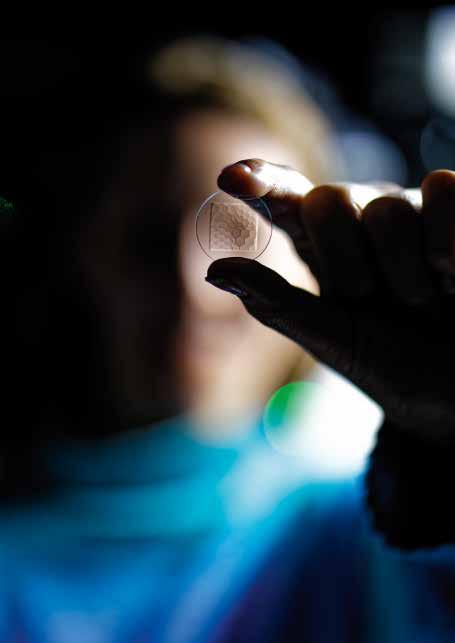

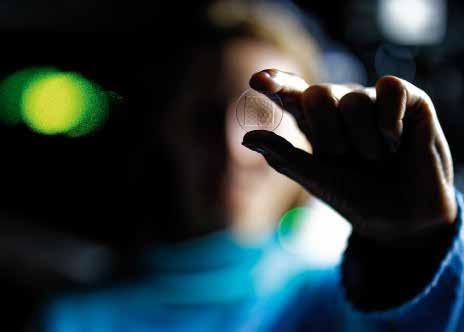
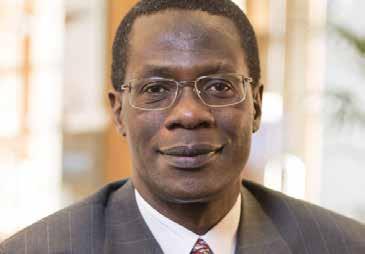
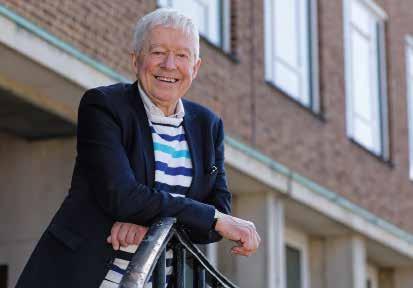
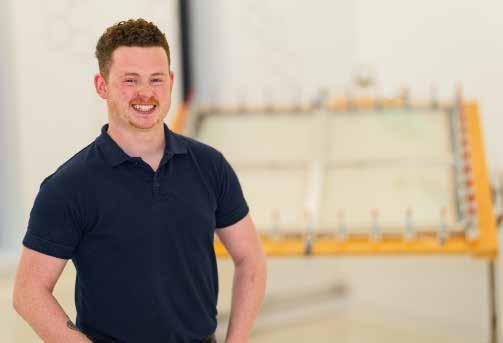







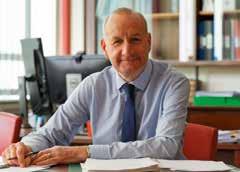
Welcome to the Spring 2025 edition of Chem@Cam. As I write Spring does seem, at long last, to have burst forth in Cambridge and before long our students will be back with their heads full of revision for the forthcoming exams and hopes of a glorious May Week to follow that. Looking back, it was wonderful to meet so many alumni and supporters (and their children and grandchildren) at the Open Day in March. It was a very popular event and Peter Wothers’ lectures went down a storm.
In this edition we have a mixture of reflections on the past and news of the present. The illustrious ‘class of 69’ reflect on their time in the Department and how this influenced their future careers, while bringing us right up to the present we have a report of the recent symposium organised in honour of Prof. Dame Clare Grey’s 60th birthday.
Carrying on with our theme of highlighting the crucial role that our technical support staff play in the success of the Department we focus on the mechanical workshops and the key role they are playing, amongst other things, in building experimental solar panels for the Reisner Group. Some of these were on display when we received a visit from the cabinet minister Nick Thomas-Symonds (the Paymaster General) earlier in March.




Chem@Cam
Yusuf Hamied Department of Chemistry University of Cambridge Lensfield Road Cambridge CB2 1EW 01223 763079
Finally, I want to welcome our new Editor of Chem@Cam and Communications Manager, Dr Fiorella Dell’Olio. Fiorella joins us from the Department of Engineering and has wide experience of the University and science communication. I am confident that Fiorella, working with Caroline and the rest of the team, will continue the high standard we have come to expect of Chem@Cam. in

James Keeler Head of Department
news@ch.cam.ac.uk www.ch.cam.ac.uk @ChemCambridge bit.ly/LinkedIn_CambridgeChem
Views expressed in this magazine are not necessarily those of the Editor, the Yusuf Hamied Department of Chemistry or the University of Cambridge.
Print: Precision
Chem@Cam is published twice a year and is sent free to chemistry alumni, postdoctoral researchers, retired staff and friends of the Department.
CONTRIBUTORS
Editor Dr Fiorella Dell’Olio
Contributor and design
Caroline Reid
Photography Nathan Pitt
Michael Webb
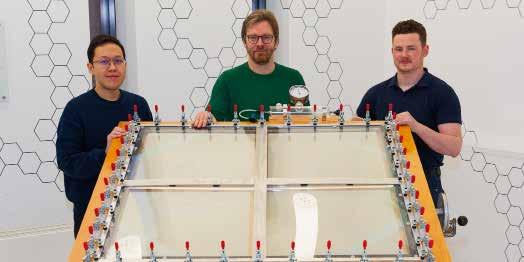
Nick Thomas-Symonds MP, the Paymaster General and Minister for EU relations, visited the Yusuf Hamied Department of Chemistry on 13 March to discuss the impact of EU research funding on scientific breakthroughs.
During his visit, he met with senior academics to explore how EU funding streams, such as Horizon and the Marie Skłodowska-Curie postdoctoral fellowship programme, have supported pioneering research at the University. Prof. Erwin Reisner welcomed him at his visit and presented a history of scientific achievements within the Department.
Prof. Reisner, a recipient of several European Research Council funding awards and host of many Marie Skłodowska-Curie postdoctoral fellows, introduced his research on developing sustainable methods to convert carbon dioxide (CO₂) and waste streams such as plastics into renewable fuels and chemicals, helping to tackle climate change. The Minister also visited the Reisner Lab and took part in hands-on demonstrations, including preparing a sample for solar reforming of biomass waste under the supervision of PhD student Beverly Low and observing hydrogen production with PhD student Andrea Rogolino.
Following the laboratory tour, Mr Thomas-Symonds attended a roundtable discussion in our Department with a panel of Cambridge ERC grant-holders and University leaders. He spoke with academics from various disciplines, including Prof. Chiara Ciccarelli (Physics), Prof. Marcos Martinón-Torres (Archaeological Science) and Prof. David Fairen-Jimenez (Molecular Engineering). The session, chaired by EU law expert Prof. Catherine Barnard, provided an opportunity to discuss the importance of continued collaboration with European institutions.
Prof. Reisner said: “The Minister showed great talent in the lab – he handled a glovebox very well and prepared a sample to produce hydrogen from biomass using solar energy. The visit provided us an opportunity to emphasise the importance of a close alliance with our friends and colleagues in Europe.”
The visit concluded with the Minister delivering the Mackenzie-Stuart Lecture at the University’s Centre for European Legal Studies, reinforcing the significance of strong UK-EU research partnerships.
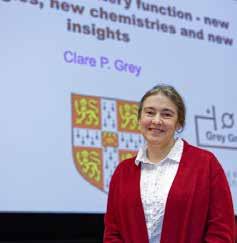
On 31 January, Prof. Dame Clare Grey delivered a keynote lecture on Battery Technology in the BMS lecture theatre in the Department. The lecture was preceded by three early-career researchers: Dr Joshua Lawrence, Dr Sayan Kar and Xinyu Liu, who presented their work on advancing energy research.
In 2009, Prof. Grey became the first Geoffrey Moorhouse Gibson Prof. when she joined the Department of Chemistry at the University of Cambridge and she is also a Fellow of Pembroke College. During her lecture, Prof. Grey reflected on her Group’s 25 years of contributions to battery research, including pioneering Nuclear Magnetic Resonance (NMR) analysis to track battery performance in real time. Her work has led to faster, more efficient batteries, and among other things, her team is now focused on developing non-toxic electrolytes made from abundant materials.
The Grey Group is actively researching ways to speed up charging times, which could transform industries such as transport by improving efficiency at vehicle charging sites. Prof. Grey highlighted the crucial role of batteries in reducing carbon dioxide (CO₂) emissions and pollution, emphasising the need for faster-charging technology.
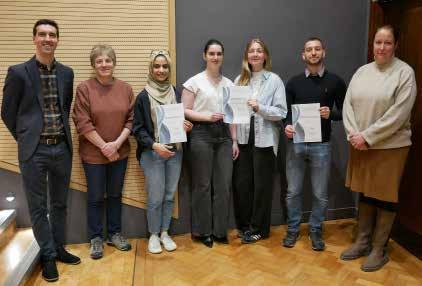
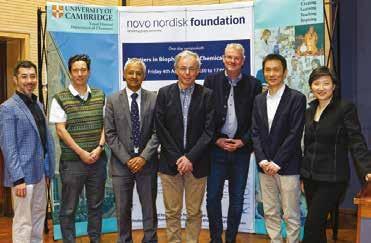
We are thrilled to announce that the winner of the Cambridge Zero Postgraduate Academy Sustainable Labs Competition is Sustainabli, led by Benjamin Yass from the Department of Materials Science and Metallurgy. This event was originated by Chloe Balhatchet, a PhD student from the Forse Group and the founder of our Department’s Sustainability Committee. The project, which uses real-time monitoring and analytics to reduce fume hood energy waste, stood out for its promising CO₂ savings, measurable impact on behaviour change and scalability across labs.
Sustainabli’s technology was developed by a US-based startup founded by former Cambridge students, making this an exciting example of innovation coming full circle to benefit the University’s sustainability efforts. In addition to reducing energy waste, the project will also provide valuable data on energy consumption, helping us better understand usage patterns and inform future behavioural change initiatives.
The competition saw outstanding entries tackling key environmental challenges in laboratories, including from the two runners-up. Cut Waste, Not Corners, led by Dr Krishnaa T. Mahbubani and Dr Rawyia Al Hosni at the Department
of Surgery, developed a practical recycling bin system for single-use plastics in biomedical research. EcoSolve, led by Laura Gorzawski and Esther Gray from the Department of Materials Science and Metallurgy, proposed a scalable solvent recovery initiative to cut chemical waste and enable reuse and recycling in-house. We commend all finalists for their creativity, dedication and commitment to greener science.
The winners were announced at the Finalist Showcase & Awards Event on 10 March, where each finalist team presented their video pitches, followed by a Q&A session. The event also featured insights from key figures working on sustainability in research across the University, highlighting the importance and momentum of sustainable lab practices.
With up to £4,000 in funding from Cambridge Zero and the Carbon Reduction Fund, Sustainabli will now have the opportunity to implement their solution and drive real change in lab sustainability. A heartfelt thank you goes to our judges, Amie Baker, Judy Hirst and Matthew Bennett, for their invaluable contributions. Congratulations to the winners and a huge thank you to all participants.
On 4 April 2025, the Department hosted the “Frontiers in Biophysics and Chemical Biology” symposium, supported by the Novo Nordisk Foundation as part of the 2024 Novo Nordisk Prize celebrations. The event was organised by Profs. Sir Shankar Balasubramanian and Sir David Klenerman, recipients of the 2024 Prize.
The one-day symposium brought together five internationally renowned scientists working at the forefront of genetics, biophysics and chemical biology. Attendees had a rare opportunity to hear directly from leading researchers and engage in stimulating discussions on recent breakthroughs across these disciplines.
The distinguished speakers were: Prof. Ed Boyden (MIT), Prof. Jason Chin (University of Cambridge), Prof. Thomas Carell (LMU Munich), Prof. Chuan He (University of Chicago) and Prof. Xiaowei Zhuang (Harvard University). Their talks highlighted breakthroughs in genetic engineering, imaging and biophysics, revealing key advances in medicine and biotech.
The symposium underscored the importance of collaboration and the Foundation’s commitment to scientific excellence and global exchange.
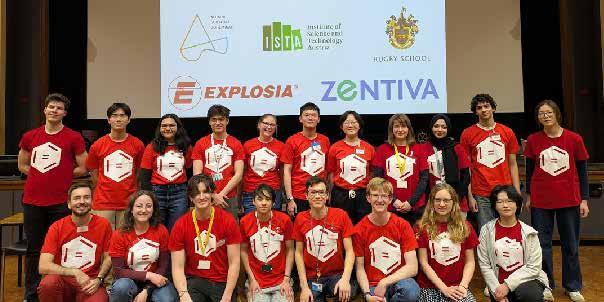
We opened our doors to nearly 300 sixth-formers this February for the 6th Cambridge Chemistry Race, an international competition that tests understanding of chemistry principles… all under a time limit.
Teams of three to five raced against each other in our BMS lecture theatre to answer questions and the best performing teams received Chemistry-themed prizes. This year the energy was palpable.
Agustin Lorusso, the organiser, says: “We are looking to establish more venues within the UK to meet demand, widen participation and build a stronger chemistry community. It would be very exciting to have past competitors join the organising committee and go on to organise their own races when they start University, just like I did.”
Chemistry Race is an international competition that originated at the University of Pardubice, Czechia and first ran in Cambridge in 2020.
The race is organised entirely by University students. Anybody is free to submit questions for the exam
and indeed the final exam had authors from the USA, Czechia and the UK. Question-writers aim to cover all areas of the A-level curriculum, but also like to include unorthodox concepts so students can stretch their knowledge.
Here is an example question students have to solve:
‘An unnameable mess’ AuXe4(Sb2F11)2 is an unusual compound containing a bond between a noble gas and a noble metal. Give the oxidation states of Au, Xe and F. Assume that all the elements have integer oxidation states, the oxidation state of Sb is +V and all atoms of one element have the same oxidation state (by Neil Waterson).
The department will host the 7th Cambridge Chemistry Race on 7 February 2026. Registration for teams will open on 1 December 2025.
Feel free to visit their Facebook page and their official website to sign up to the mailing list to stay up-to-date on the latest news and deadlines. You can also access the previous challenge questions and answers to challenge your chemistry knowledge.
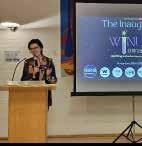
At the end of 2024, Women in Neuroscience UK hosted the inaugural WiNUK Awards in our Cybercafé. There were over a hundred nominations from 16 universities across the UK and eighty people were in attendance. The keynote lecture was delivered by Dr Flaminia Ronca on sport and the female brain which dove into cognitive and physiological variations experienced by athletes across the menstrual cycle.
The awards categories showcased early career women in research, at undergraduate, postgraduate and group-leader levels and leading researchers in different neuroscience topics, along with other important categories like sex/gender research, mentorship and science communication.
The WiNUK network was started by Elizabeth (Lizzie) English, who is in the final year of her PhD in the Klenerman Lab studying Alzheimer’s Disease. She stated: “This event aimed to uplift the neuroscience community and support women in neuroscience to improve confidence, visibility and inclusive workplaces, towards balancing the gender gap in leadership. We couldn’t have done this without the help of our amazing volunteers on the day, the judges who helped curate the nominations and our kind sponsors.”
The next WiNUK awards will be in November this year, so watch their socials @WomenInNeuroUK.

The Innovation Centre in Digital Molecular Technologies (iDMT) organised a skills workshop jointly with Materials Innovation Factory and hosted by the Royal Society of Chemistry in London in October 2024. “Making Digital Labs a Reality – Skills Workshop” was a oneday workshop where participants explored innovations in digital laboratory technologies and discussed the essential digital skills needed to prepare the next generation of researchers in chemistry and chemical engineering.
The Centre of Excellence was officially launched in July 2024, supported by eight companies and the University of Cambridge, providing funds for Centre operation, business development, research leadership and organisation of the events.
During September, the iDMT hosted its first summer school: Digital Technologies for Chemical Research & Development. The event brought together participants from industry and academia who learned the latest advancements in digital technologies for chemistry R&D.
The programme combined practical sessions and lectures, providing attendees with a comprehensive understanding of the current landscape and future directions in this rapidly evolving field, such as a practical session on lab automation using the Python environment FLab, developed and presented by Accelerated Materials Ltd. Five participants out of 17 were from industry members of the iDMTConsortium.
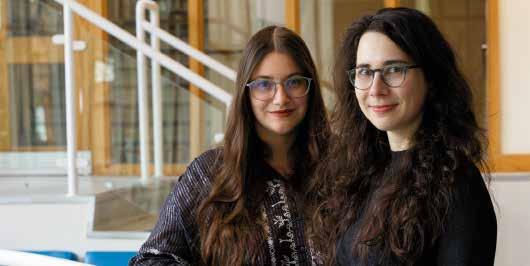
Our postgraduate representatives, Ioana Băltărețu (left) and Dorothea Böken (right), share their thoughts about the role and their vision for postgraduate life and wellbeing in the Department.
As postgraduate representatives, their main responsibilities have included representing postgraduate students at Postgraduate Education Committee (PEC) meetings, ensuring that student concerns are brought to the Department and actively addressed. They also have regular meetings with the postgraduate education team to discuss student issues and, for example, worked on responses to the annual postgraduate survey. This involved not only addressing key concerns raised by students but also ensuring that they were informed about how their feedback was being used.
Dorothea, a final-year postgraduate student in the Klenerman Group, focuses on the development of singlemolecule techniques to study tau protein aggregates. Her research aims to achieve a better understanding of the molecular mechanisms behind Alzheimer’s disease and other neurodegenerative diseases.
Dorothea comments: “I started my PhD in Lent term during COVID, a time when many of the usual support structures and student networks were disrupted. The lack of in-person events made it harder for new PhD students to navigate
the Department, connect with peers and find the resources they needed.
“I wanted to ensure that future postgraduate students had a smoother transition, with better access to clear information, support systems and a stronger student community. Becoming a postgraduate representative allows me to advocate for these needs while helping to improve communication between students and the Department.”
Ioana is a 2nd-year PhD student in the Phipps Group who is working on enantioselective catalysis using transition metals. Her research develops new reactions that could make chemical synthesis more wide-ranging, sustainable and cost-efficient.
Ioana comments that: “I truly believe that education shapes society and it’s our duty as students to be responsibly proactive in securing the best possible development. In my role as postgraduate representative I am trying to consider whether the services and opportunities the students are provided with are up to the highest standards.”
Dorothea adds: “Overall, serving as a postgraduate representative has been a rewarding experience, providing valuable insight into student advocacy but also into the workings of the Department. I hope that my contributions have helped improve the postgraduate experience.”
Olivia Dovernor built a 3D fluorescence microscopy system during her PhD, pioneering new ways to map gel network structures and track molecular diffusion. Alongside her research, she led entrepreneurial initiatives within St John’s College inspiring and mentoring founders. Now, she applies her technical and strategic expertise as a consultant, supporting digital transformation in the public sector.
Olivia’s PhD research sat at the intersection of fluorescence microscopy and materials science, a space where imaging technology meets the challenge of understanding complex materials. While fluorescence microscopy has long been used in biological applications, Olivia’s focus was on applying and adapting these techniques to study hydrated materials. In particular, polymer networks and gels which have significant potential in drug delivery and biomedical applications.
Her work involved both the development of advanced imaging techniques and the synthesis of novel fluorescent dyes to better visualise and analyse material structures at the molecular level.
This dual approach – combining optics and materials science – meant that Olivia had to work across disciplines. She became adept at manipulating light and microscopy hardware, as well as understanding the chemistry and physics of the materials she was imaging. By working at this interface, she improved the way researchers visualise and quantify molecular interactions within these materials, providing insights that could directly impact their design and application – an understanding that has not before now, been achieved.
One of the key advancements in Olivia’s research was moving from traditional 2D fluorescence microscopy to a more advanced 3D-imaging system. Conventional fluorescence microscopy captures images in a single focal plane, which can be limiting when studying materials with
complex internal structures or tracking the movement of molecules over time. Olivia addressed this challenge by modifying a standard widefield fluorescence microscope, integrating custom optics to convert it into a Fourier Light Field Microscope (FLFM).
By incorporating a custom microlens array into the optical path, Olivia’s setup was able to capture multiple perspectives of a fluorescent sample simultaneously, allowing for volumetric imaging without the need for mechanical scanning. This innovation meant that, instead of acquiring images one plane at a time, a large section of the 3D structure of a sample could be reconstructed from a single acquisition. The result was a significant improvement in both depth and precision – offering up to a 32-fold increase in imaging depth compared to traditional 2D methods, as well as maintaining nanometer-scale localisation accuracy.
The benefits of her approach extend beyond structural understanding. Because the system allowed for continuous tracking of fluorescent molecules over extended timeframes, Olivia’s research demonstrated its unique value in studying diffusion processes –key to understanding how small molecules move through polymer networks.
“This will be particularly important in the context of drug delivery, where the controlled release and movement of pharmaceutical compounds within complex gel-like materials is crucial to their effectiveness.” Her findings introduce a different level of sensitivity, offering a new way to observe molecular interactions in real-time within water-based materials. There is a lot of potential with this enhanced piece of equipment to guide the development of more effective materials by simultaneously coupling microscopic 3D imaging with macroscopic rheology.
Through her PhD, Olivia advanced the technical capabilities available to soft-matter researchers and demonstrated the power of cross-disciplinary research in solving complex scientific challenges. She shared her time between the Melville Laboratory for Polymer Synthesis, directed by her co-supervisor Prof. Oren

Scherman and the Lee Lab with her other supervisor Prof. Steven Lee. “I achieved many firsts during my studies which has been the exciting thing of pushing boundaries by combining two separate fields.”
Olivia received great feedback during her viva, which she “thoroughly enjoyed, it was such a lovely end to my four years in Chem!” She has since transitioned to working in public sector consulting, supporting digital transformation in the public sector.
Olivia has been involved in business and entrepreneurship since before her PhD.
“My interest in business grew when I won a pitching competition for Geovation Scotland in 2021, after which, I received close mentorship from professionals in the business and technology world including from Microsoft.”
She also got involved in college entrepreneurship at St John’s College and has helped regrow the community after Covid, designing a programme of events during her time as
president from 2022. “It has taken a few years to establish a strong vision in St John’s hence why I am still the president now in 2025, but I am just about to hand over The Johnian Entrepreneurs Club’s presidency this year to the next very capable generation! Having grown the community in college to over 100 people from about five, I’m very proud of what my committee and I have achieved.”
“My involvement in entrepreneurship has ‘made’ Cambridge for me and is something I will be actively involved in and a member of for a long time. I believe that extracurriculars made a difference in getting my role now and helped tremendously when in hard PhD-related moments.”
Olivia reflects that: “I experienced challenges in both my PhD and business environments that I learnt to overcome and generate quality products. I also discovered where my interest lies and hence, where to go next in my career. Now I am applying these varied skills in a real-time and realworld application – a very interesting and technical role which I’m excited to see where it takes me”.
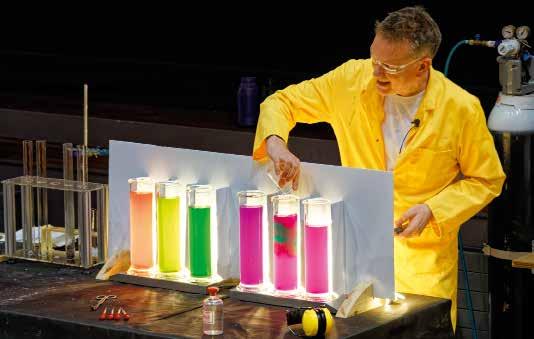
Wethrew our doors open for the Cambridge Festival with an Open Day that was bigger, better and more squelchy than ever! With activities throughout all the teaching laboratories and amazing lectures from our scientists, the Cambridge Festival was in full swing and building momentum with visitors reaching levels similar to those before Covid.
Prof. Peter Wothers put a new spin on his chemistry demonstration lecture with ‘Free Range Chemistry – No Added Chemicals’. Peter wowed audiences with incredible reactions which included creating colourful vapours from seaweed and exploding nitroglycerine prepared from natural ingredients. This was all accompanied with Peter providing an accessible explanation into the chemistry behind these incredible reactions. This is the second packed-out Open Day demonstration lecture since Covid.
Over 100 alumni had reserved seating for Peter’s first lecture and afterwards enjoyed a buffet lunch in the
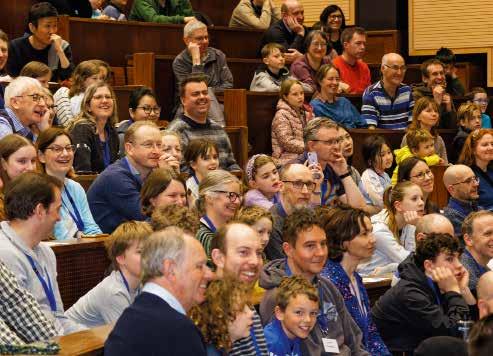
Department. The details of next year’s alumni lunch will appear in the winter edition of Chem@Cam with instructions on how to book for the next event.
Prof. Erwin Reisner’s lecture, entitled ‘Solar Chemical Technologies’, focused on an emerging technology that uses sunlight and waste as a precious resource in a circular economy. He discussed how his work is recontextualising waste products, such as greenhouse gases, carbon dioxide, non-edible biomass and plastic waste, as valuable resources. Using these ingredients his Lab produces sustainable fuels and chemicals for energy storage, transportation and the chemical industry.
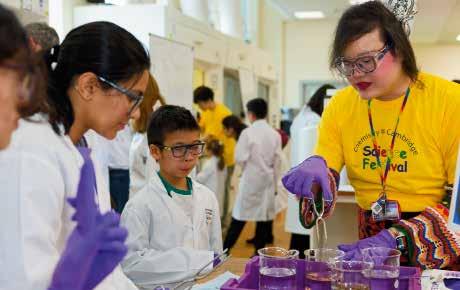
The concept, design and prototypes of devices performing solar chemistry for a net-zero 2050 economy were presented, along with a device display of his solar cell which is discussed on page 26.
There was also a PET recycling bin available where visitors could deposit their used water bottles for conversion into hydrogen. Prof. Reisner hopes to have more of these throughout the Department in the future.
Alongside our amazing speakers and Department-run events, we hosted CHaOS (Cambridge Hands-On Science), Cambridge’s biggest student-led science outreach group. They filled the IA Teaching Laboratory and the car park with over 30 hands-on activities for their annual event ‘Crash, Bang, Squelch’ and ran over 30 hands-on science experiments with student volunteers. Visitors could find out the answers to questions like: why hot air balloons float and how your lungs work.
CHaOS also presented a series of talks about weird and wonderful science and ran a robotics workshop where visitors had the opportunity to design and programme small moving robots. We look forward to welcoming CHaOS back to the Department in 2026!
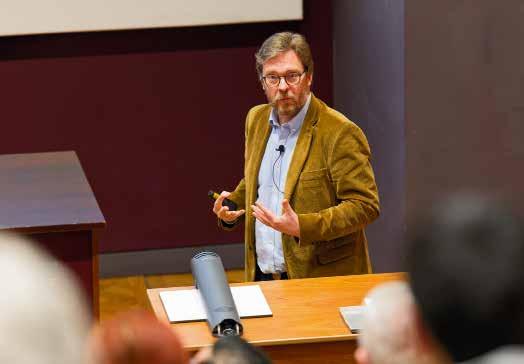
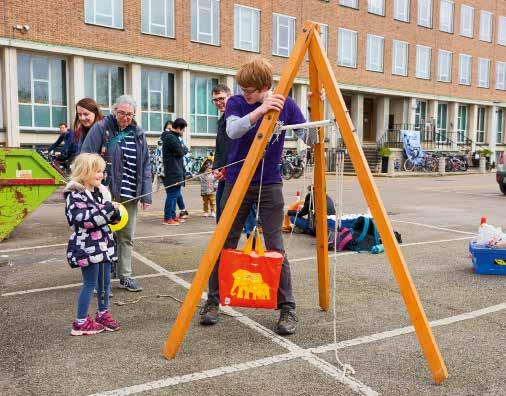
Mokaya OBE FRS did his PhD in Prof. Bill Jones’ Group and has recently been elected as the next President of the Royal Society of Chemistry (RSC). He talks about his journey as a scientist starting in Nairobi, his vision for the future of chemistry and everything that’s happened in between.
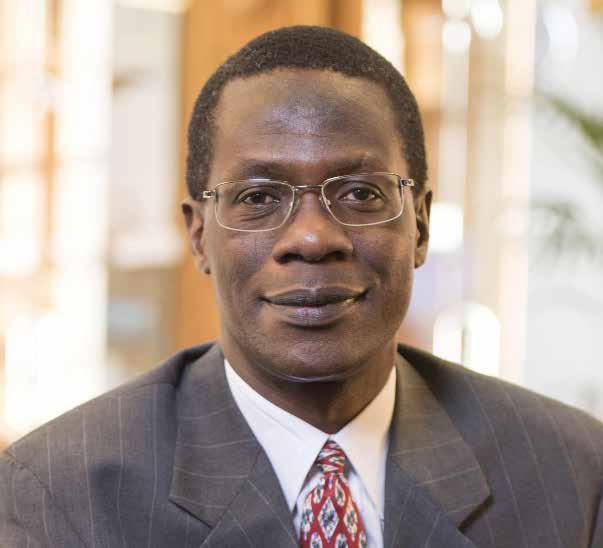
Materials at Nottingham
Robert has been Provost and Deputy Vice-Chancellor at the University of Sheffield since 2024. Previously he was Prof. of Materials Chemistry at the University of Nottingham where he had been since he left the Department in 2000.
After his PhD on porous clays in the Department (1992), Robert held a Junior Research Fellowship at Trinity College (1992-1996) and an Engineering and Physical Sciences
Research Council Advanced fellowship (1996-2001) during which he left Cambridge and continued research on sustainable porous materials with his Group at Nottingham and now in Sheffield. He develops simpler and cheaper methods to synthesise materials that are essential in renewable and sustainable energy applications. His work has led to improvements such as increasing hydrogen storage or CO2 capture and storage (CCS) in porous materials.
Years before he started his research journey in the Department, Robert grew up in Kenya and studied chemistry at the University of Nairobi.
“The University of Nairobi has changed significantly since my time there but when I did my undergraduate degree, we spent a lot of our time without any equipment and were only able to imagine how to use, for example, an IR spectrometer.
“If there was equipment then it was usually one unit and only the technician could use it, so we could only watch. Back then it was very different to the experience of being an undergraduate in the UK. The difference has shrunk since then.
“I had a wonderful time at the University of Nairobi and the chemistry degree was great and it stretched us. I still have strong links with my alma mater.”
After his first degree, Robert worked for a short time with Unilever researching how to clean up cooking oil with porous clay materials. He had an inclination to study longer. While wandering the pavements of the University of Nairobi, he saw an advert for Cambridge PhD scholarships on a noticeboard and decided to apply. This is how he came to join Prof. Bill Jones’ Group studying porous clays.
“It was a coincidence that when I came to Cambridge, the project Bill Jones had for me was on clays and how they work as adsorbents at the molecular level for refining edible oils, the very same materials I had been using in my Unilever job in Nairobi to refine vegetable oils at scale for the Kenya and East Africa market!
“I want to highlight that my time in Cambridge was key in how I have developed my career. Working with Bill and then spending time in my first position as a Junior Research Fellow at Trinity College set me up to always allow myself to think along the lines of: I can do this! I can do that! and not to limit myself with respect to my goals. I never know quite how I’m going to do it, but the first step is thinking that I can do it.”
Outside the laboratory, Robert played a lot of squash at the Trinity College Grange Road squash courts and has fond memories on the Cam punting with friends to Grantchester for picnics and back.
Over the years, Robert has supervised many students and his motto is that there is always something new to learn. He is keen to help students realise their potential regardless of where they come from or their background.
“In Bill, I learned what it was like to have a great supervisor who listened, encouraged us to innovate and created a close community and these are lessons I try and bring to my students now.”
Robert has been working with the RSC exploring equity and inclusion within the chemical sciences and found clear gaps in representation in the chemical sciences community.
“The chemical sciences are not using the full diversity of available talent and that

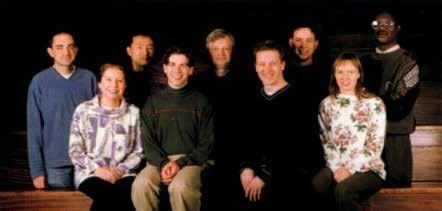
has been the spur for me to shine a light on inclusion and equality.”
The RSC has started working on initiatives supporting underrepresented groups. An example of such an initiative is Broadening Horizons, a pilot programme which is now into its fourth year. The programme targets students from Black and minority ethnic backgrounds who are early in their science career and offers them insights that encourage them to aspire to the very highest level in the Chemical Sciences. It offers industrial placements and mentorship. The programme has supported over 300 scholars so far.
Robert will be stepping into the Presidency of the RSC in 2026 after
being elected last year following a period as President-Elect (2024 – 2026).
Sharing his vision in the RSC’s role, he states: “For me, the RSC has been very important in my professional career, so I hope to see the organisation continue to be the trusted voice of chemical scientists in the UK and globally. I want us to be at the forefront of conversations on finding solutions to current challenges, be that climate change, sustainability, or equality in participation in the chemical sciences.”
In response to emerging trends, he says: “We are a publisher and are moving towards open access where we want to be seen as a leader that others can trust and follow. We also want to be at the forefront of game-changing trends such as in artificial intelligence and stay active in these conversations.”
The legacies of two well-loved Department supervisors, Martin Mays and Jim Staunton, remain vivid for many who had the privilege of working alongside them. For the younger scientists who joined during the transition from the turbulent ‘60s to the disco ‘70s, their time in the Department continues to hold a special place. Four of these individuals reflect on how their experiences during this pivotal period continue to influence their lives today.
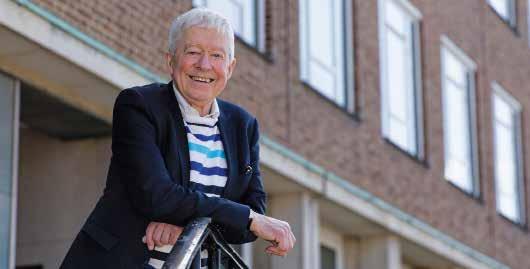
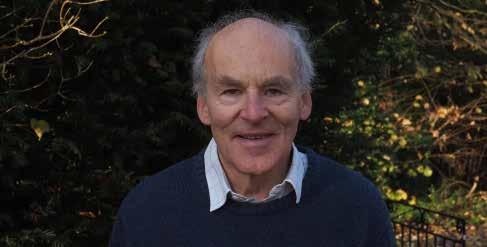
Philip read Natural Sciences here before going on to complete a PhD with Geoff Wilkinson at Imperial College. Philip had a successful career teaching Physics and Chemistry first at St Paul’s School and eventually becoming Headmaster at Bedford School. He was awarded an OBE for his role in advising both the Major and Blair administrations on education. He retired in 2008 and lives in France.
I think the ‘60s in particular was a special time and we undergraduates were very lucky. Cambridge as a University was more open to all, regardless of social or educational background. Getting a place at the University was increasingly a matter of ability rather than which public school you had attended or who your father was.
Key figures who stood out were Dudley Williams (Churchill), Jack Linnett (Sidney Sussex) and Alan Sharpe (Jesus), who taught me. Lord Todd was Head of Department, but because it wasn’t unified yet, when you entered you had to turn left to get to physical chemistry and right to organic chemistry! We had the last ever Tripos practical examination of seven hours before the final move to continuous assessment; the student opposite me cooked kippers in a beaker for his lunch! There was still a long vac term that summer, when I did practical work in the labs in the morning and learnt to punt in the afternoon.
It’s easy to forget how privileged we were: University was free and the means-tested grants – not loans – were adequate to live on. Much has changed socially and so on but much has remained the same too. The Lensfield Road building still looks on dispassionately as students continue to enjoy their chemistry.
Robin read Natural Sciences here and started his PhD with James Turner, completing it at the University of Newcastle when Jim moved his Research Group there. After positions in Mülheim, Edinburgh and Oxford, Robin joined the University of York in 1983, where he led a Research Group in organometallic photochemistry, small molecule activation, catalysis and solar fuels. He was elected as a Fellow of The Royal Society in 2010. He has just published an interdisciplinary book on photochemistry and photobiology.
I think what was special was the education we had and the demands it made on the students. I also met some remarkable people. Ian Fleming was my supervisor for organic chemistry; his clarity was amazing. And of course Jack Lewis was a lovely character, always taking an interest. I learnt it’s the people that count. The most direct effect of the “60s zeitgeist” for me was that students started expecting their voices to be heard. Staff didn’t really know what to do with the new student committees and weren’t very good at listening! I probably first got to know Anne Lyon when we were committee members. I think our biggest achievement was that the physical chemists were allowed to share the coffee room with the inorganic/organic chemists.
One of the issues that concerned me over the years was the lack of women in science. I am proud of my role in achieving the Athena SWAN gold standard in York chemistry. I have to say, Cambridge was appalling in the ‘60s: there were no female academic staff and the number of female undergrads was tiny. The changes have come very, very slowly, but things are getting better. I’m pleased to see one of the most recent appointments was Ruth Webster, an inspired appointment in inorganic chemistry.
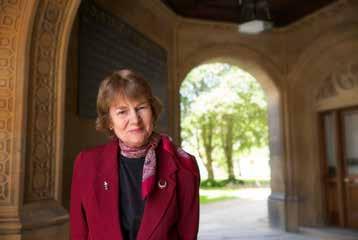
Newnham 1967
After obtaining a Natural Sciences degree, Anne completed her PhD here with Colin Reese and Jim Staunton. Anne then held a Research Fellowship and Lectureship in Chemistry at Girton. In 2016 she became the first female Emeritus Fellow at Gonville and Caius and retired as Director of Development there. Anne continues to sit on College and University committees and is a valuable member of the Department’s own Philanthropy Group.
Lab 122 was a mixture of PhD students and postdocs, and as a group we really bonded. I was the only woman in this 20-man Lab until Janet Stevenson joined, but I didn’t feel patronised and really trusted and enjoyed working with my male colleagues. In 1969 my campaign to be elected one of the first student representatives on the chemistry Department committee may well have been successful because I focused on getting the first coffee machine for students in the building.
At Newnham I had an inspiring Director of Studies who was a chemist, Dr Delia Agar. I also remember Dr Alan Sharpe from Jesus College, who used to supervise Newnham students for inorganic chemistry and broaden our education by taking us to operas at Covent Garden.
During the first year of my PhD Lord Todd came into the Lab and said: “Where is Miss Butland?” I was not hard to find as I was the only female. I was worried because ‘Todd was God’. I was relieved to find he only wished to congratulate me on proving the structure he had given di-N-aroyl derivatives of adenosine in the 1930s was not correct. It was not difficult with the infrared, ultraviolet, NMR and mass spectrometry evidence available by the early seventies. None other than future Head of Department Jeremy Sanders helped me with this analysis.
Three inspiring people from those days died last year: Jim Staunton, Martin Mays and postdoc Dennis Buckley. And now Eddie Powell has gone. I remember them all fondly.
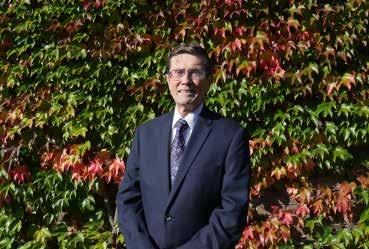
Churchill
Eddie completed his undergraduate degree in Natural Sciences in 1970 followed by a PhD here with Martin Mays. He went on to have an eventful career in finance and start-ups and was a well-known entrepreneur and business angel in the Cambridge bio-tech hub. He told us he had ‘mostly retired’ 13 years ago and was enjoying travelling with his wife by train.
This testimonial was given before Eddie sadly passed away on 14 March 2025. We are honoured to share his words in remembrance.
I never had a dull moment between social life, rowing and trying to get on with my research. I mention the research last because it took up any spare time that was available. I would be in the Lab on a Saturday or Sunday; I was there any time I wasn’t doing something else, often late into the night. In those days there was more freedom to go into the Lab anytime on your own and do experiments. It’s much safer now!
I enjoyed the social life at Churchill and met my wife there. I also took up rowing and continued during my PhD. We rowed six days a week at one o’clock in the afternoon. I enjoyed the chemistry and certainly remember some exciting events when I was doing my research. I operated a vacuum line and dropped a flask of isocyanides that were very noxious and smelly. The whole Lab was evacuated and I had to wear safety equipment and clean it up myself.
I was in a big Lab with eight benches, so there were always lots of interesting people around. I particularly remember a very interesting Lab technician named Wally – he was past retirement age but came in and helped anyway. I also got to know Brian Johnson, who had some group members in the Lab. In fact he and his wife came around for tea recently.It shows you how those friendships we made then last a lifetime.
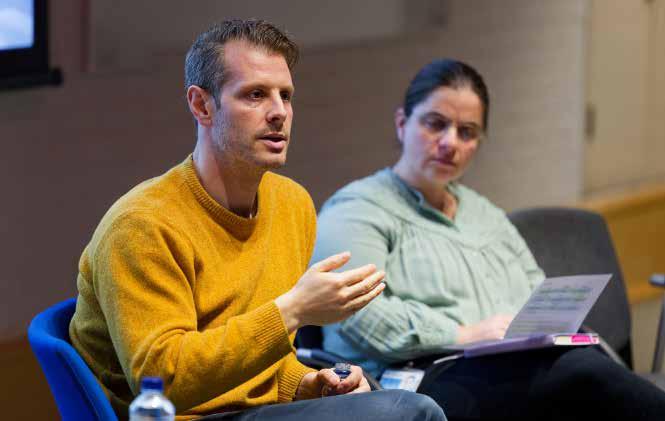
TheChemistry Sustainability Committee hosted a conversation between Dr Svetlana Menkin from our Department and Dr Spencer Brennan from Neutreeno, a company that helps large companies reduce their carbon emissions.
Spencer introduced the principles of how Neutreeno’s technical system works and the ensuing conversation with Svetlana focussed on how to meaningfully improve industrial supply chains to reduce energy consumption, increase efficiency and even reduce operational costs for the company seeking to improve its sustainability profile.
Spencer did his PhD in Physics at the University of Cambridge (Trinity Hall) and has been studying environmental impacts for the last 15 years. His research during his academic career looked at preventing and cleaning oil spills and renewable energy converters. In this context, he acquired a broad idea of some problems facing the environment and developed methods to tackle them.
Aware of these challenges and feeling compelled to be part of the solution, Spencer founded Neutreeno together with an expert team of Cambridge climate scientists and engineers. Neutreeno began as a Cambridge Enterprise startup in 2020 and since then, it has worked with the Cambridge Institute for Sustainability Leadership. Through extensive research, their team has mapped materials flow and emissions of entire global supply chains across 37,000 facilities.
These emissions are passed onto the large companies using their products and services as “embodied emissions”. Their work has allowed companies to reduce the uncertainty of their emissions compared to global average measurements and to influence effective decisions about their supply
chains and production lines. For example, they are working with the NHS to supply more carbon-efficient medicines and materials.
Spencer says: “When we know exactly where the emissions come from, we know where we can improve and make the supply more efficient. We have the tools for innovation now, the big challenge is about implementing it. We need to reduce our emissions globally and we need to get the existing technology out of universities that helps make these changes and Neutreeno is about bridging that gap.”
Dr Nick Bampos, Deputy Head of Department comments: “These are important conversations that trickle back into the Research Groups to help improve the way we do science and drive innovation.”
The Chemistry Sustainability Committee was started in 2023 by PhD student Chloe Balhatchet from the Forse Group and is made up of students and staff from across the Department. It works to implement effective change within the Department, as well as on engagement events like the “In Conversation” series.
The next “In Conversation” event being hosted by the Chemistry Sustainability Committee will be in the Easter term. If you are interested in joining the Committee to contribute to the important work being done please email sustainability@ch.cam.ac.uk.
Choy Boy and Siobhan Johnson were recipients of Yusuf Hamied Studentships for their PhDs. Three years later, they share their achievements and aspirations.
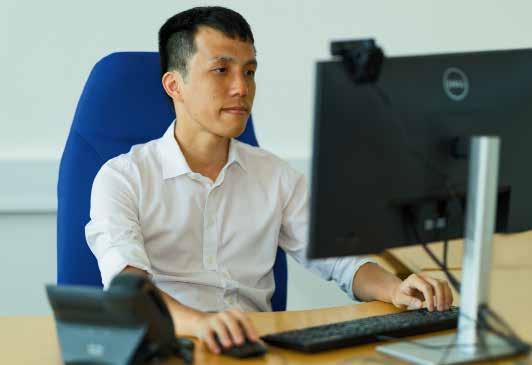
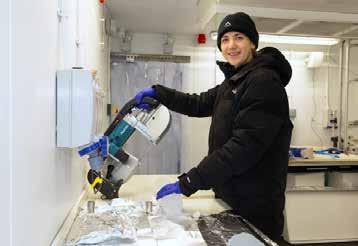
In 2021, Dr Yusuf Hamied (Christ’s 1954) gave a transformational leadership gift to the Department which included support for distinguished scholars at postgraduate level. This fund has been a landmark moment for Choy from the Wales Group and Siobhan from the Giorio Group whose studies have taken them on vastly different journeys in Cambridge and around the globe.
Choy Boy
Wales Group, Quantum computing Girton College, 2023
Choy works at the fundamental level studying quantum computing and computational chemistry that can help researchers in the lab further down the line. Quantum computing shows promise for tackling a wide variety of problems in molecular science and chemical physics much faster than classical computers.
“After my PhD studies, I want to acquaint myself with more aspects in quantum computing. I’m interested in a postdoc as well as industrial positions in companies seeking a share of the lucrative quantum computing pie.”
Upon receiving the studentship, Choy was “absolutely ecstatic” as obtaining a fully-fledged PhD scholarship can be challenging for international students.
“I am extremely thankful to the Hamied Foundation. They went above and beyond, even working with my College and Cambridge Trust to ensure that my funding package is as complete as possible.”
Siobhan Johnson
Giorio Group, Antarctic biochemistry Magdalene College, 2022
Siobhan researches Antarctic sea ice and how its organic composition varies regionally and seasonally. Sea-ice algae produces fatty acids which are then found in the sea ice and the underlying water. These measurements and observations of the changes of the fatty acid composition can help build a picture of the sea-ice algae community and how it may change with the annual changes of the sea ice. These observations can be used to calibrate paleoclimate models which are essential for global and Antarctic climate projection models.
The PhD involves working between laboratories at the Yusuf Hamied Department of Chemistry and the British Antarctic Survey, as well as visiting the Antarctic to collect sea-ice samples. On top of these amazing networks, Siobhan also enjoys being part of Magdalene College, noting: “It has become a wonderful source of community for me here. I am eternally grateful for receiving this funding, because not only has it allowed me to continue doing something I love and find valuable, but has allowed me to do so in an environment that is supportive and nurturing of my research career.”
TheFaraday Undergraduate Summer Experience (FUSE) is an internship programme for undergraduate students to help undergraduates gain research experience in battery technology.
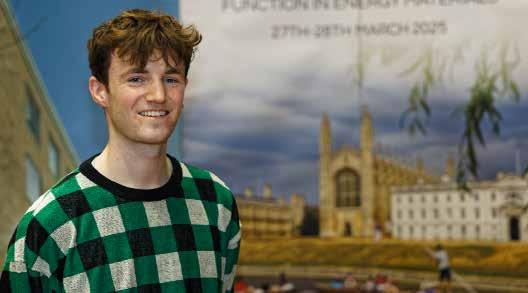
Last year, our Department hosted three FUSE interns where they joined groups to experience real laboratories and research alongside supervisors. This valuable opportunity has helped previous FUSE interns continue their research journeys.
Cassidy Ashworth
Supervised by Prof. Dame Clare Grey and Dr Hrishit Banarjee. Masters in physics at the University of Cambridge.
Cassidy focused primarily on computational and theoretical physics during his Bachelor’s degree, with a particular interest in the physics of materials. His in-depth literature review on solid-state batteries provided an excellent foundation for his research placement through the FUSE internship programme.
During his internship, Cassidy worked with both the Grey Group in our department and the Banerjee Research Group in Dundee, developing computer models to simulate how X-rays travel through different lithium-ion battery cathodes. Just as X-rays are used in medicine to image bones, they can also be used to examine the internal structure of batteries. In this case, the focus was on the cathode – the component responsible for storing and releasing charge.
He investigated cathodes made from varying proportions of lithium, manganese and phosphate, predicting how their structure influences battery life and performance. These predictions are crucial in helping researchers design future batteries that charge more quickly, last longer and operate more efficiently.
Reflecting on the experience, Cassidy said: “I presented my work at the Faraday Institution Degradation Consortium at the Royal Society of Chemistry, which was nerve-wracking but also a great experience.”
Hrishit, his supervisor from the University of Dundee, commented: “I was pleasantly surprised and also humbled by the way he handled the difficulty of the project. In a short amount of time – especially by research standards –he managed to complete a significant body of work. We fully expect his contributions to form part of an upcoming publication.”
Cassidy’s work not only showcases the value of interdisciplinary research, but also demonstrates the meaningful impact that early-career scientists can have on tackling real-world technological challenges.
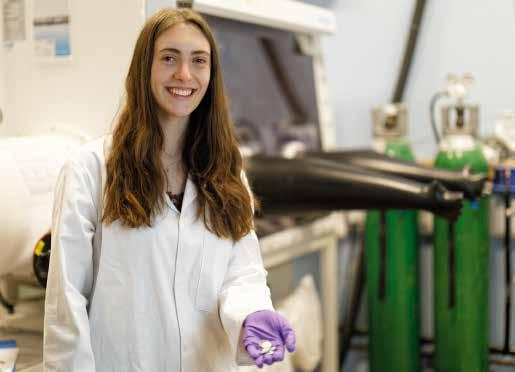
Supervised by Prof. Dame Clare Grey and Dr Debashis Tripathy. Clara Morgan, a third-year student on the Master’s degree in Chemistry at the University of York, completed an internship with the Grey Group at the University of Cambridge.
During this placement, she worked on a project titled “Performance and Ageing Evaluation of Li-ion Batteries with Novel Formulations.” The project aimed to understand how lithium-ion battery materials degrade over time and how performance can be improved for more reliable, longer-lasting energy storage. Her findings were presented in a scientific poster at the end of the eight-week placement.
Clara focused on evaluating different electrode materials, exploring how slight changes in composition and cycling conditions affected battery performance. She investigated the effects of high charging rates (2C, 3C), which led to faster degradation compared to the standard 1C rate. Some materials demonstrated better capacity retention over time, offering promising implications for real-world applications such as electric vehicles and grid storage.
Her interest in materials chemistry – particularly the relationship between structure, composition and function – was deepened through the project. The experience reinforced her passion for using chemistry to address sustainability challenges and develop advanced energy technologies.
Clara gained practical experience in glovebox operation, coin cell assembly and battery cycling using BioLogic and Arbin systems. She also observed X-ray photoelectron spectroscopy (XPS) and conducted gas analysis. Her scientific writing skills were enhanced through the development of her research poster. She became proficient in OriginLab and EC-Lab software for electrochemical data analysis.
The internship confirmed Clara’s desire to pursue a career in battery research and will directly support her upcoming industrial placement with a company connected to the Faraday Institution. Originally from Cambridge, she attended Sawston Village College and Hills Road Sixth Form College. This opportunity offered her a new perspective on University life in her home city and a chance to collaborate with fellow interns and researchers in a highly inspiring environment.
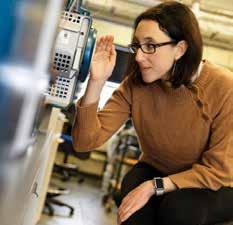
We are a partner in the Evaluation of Climate Intervention through novel Potential Strategies (ECLIPSE), a new project by the National Environment Research Council. The project will be a multi-partner endeavour to create a report guiding informed climate intervention. Prof. Chiara Giorio and Prof. Alex Archibald, both professors of atmospheric chemistry, will be contributing to ECLIPSE.
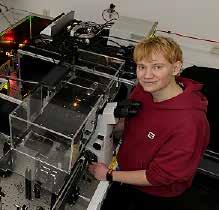
Sam Daly, a PhD student in the Lee Lab, is first author in a paper that was in the top 25 physics articles of Nature Communications in 2024. The paper, High-density volumetric super-resolution microscopy, looks at current approaches for super-resolution microscopy using hexagonal arrays like the one on the front cover. This new approach is faster compared to previous methods and gathers more data in more dimensions.
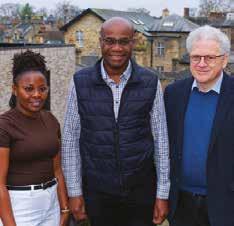
Alumnus Kelly Chibale has been elected to an Honorary Fellowship at his alma mater, Queens’ College. The Honorary Fellowship is the latest in a string of honours and awards that have recognised Kelly’s outstanding research, leadership and innovation. Kelly completed his PhD in synthetic organic chemistry in the early 90s under the supervision of Stuart Warren.
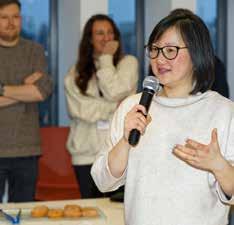
Congratulations to Associate Prof. Jenny Zhang who was chosen by postgraduate students in our Department as the Outstanding Supervisor of the year 2025. The award began in 2020 and was designed to celebrate excellence in the supervision of research students. A postgraduate supervisor plays a huge role in an early career researcher’s life and the award is designed to encourage excellence in this leadership.

The Black Women in Science Network, founded by Tomi Akingbade, a PhD student in the Klenerman Group, organised a networking brunch for Black women in Science from all across the UK this March. The brunch brought together Black women scientists for socialising and networking, including a talk from Isang Emeneka, a PhD student in psychology at the University of Westminster.
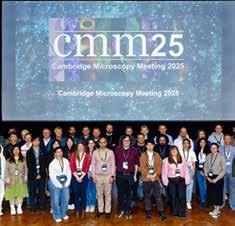
The Cambridge Microscopy Meeting on 7 April was a dedicated forum organised by and for microscopy developers in and around Cambridge. The meeting featured talks and posters, highlighting advancements in light microscope development and applications. The event was organised by PhD student Shengbo Yang from the Lee Lab and Dr Brendan Cullinane from the University of Wisconsin-Madison.
Robin, a third-year PhD student in the Zhang Lab studying how we can generate electricity from tiny photosynthetic bacteria called cyanobacteria. To supplement their PhD, Robin did a three month internship at Kew Gardens as part of the Professional Internships for PhD Students (PIPS) programme.
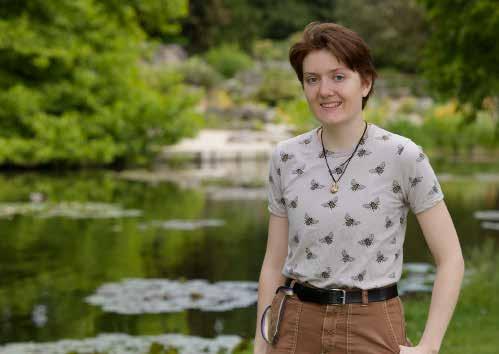
It is part of the Cambridge Nano Doctoral Training Partnership PhD Programme (NanoDTP) that helps early career researchers gain experience in a non-lab based environment.
“I love talking about science, I love trees and I wanted some experience at a job that is still science-related but a little more creative. The Kew Gardens internship fit perfectly into my interests. They do a lot of good in the world for preservation and biodiversity and I got to meet so many different types of scientists.”
The biggest project Robin worked on was supporting the team going to the Sixteenth Meeting of the Conference of the Parties to the Convention on Biological Diversity (COP 16). It is the second biggest COP with 168 signing countries.
Part of Robin’s role was to write material about digital sequencing information (DSI). Plant researchers collect data on thousands of plants from around the world, including information about their genetics or compounds they produce. This information is incredibly useful for science and industry, but it’s important that any benefits that come from using it make it back to the people and places where they’re needed the most.
Governments and organisations around the world were trying to put in regulations to make this happen.
Robin says: “The COP16 saw some successes such as securing agreements on the creation of a new “Cali” fund to share the benefits generated by use of DSI and a permanent body for Indigenous
Peoples. There’s still a long way to go before we have a fully equitable global benefit sharing system.”
The Millennium seed bank in Surrey is an underground storehouse filled with seeds from all over the world. They are in partnership with ninety different countries to store duplicate seeds and provide training so that locals can take charge of their own conservation.
“I was lucky to go to the Millenium Seed Bank to scope out some stories for National Tree Week. One was about seeds adapting to climate change, a tree seedling quiz and one about zapping seeds with lightning to help them grow better. I also took videos for social media coverage for all these stories.”
Robin also had the opportunity to interview a researcher who went to Disko island to collect seeds for the bank. They used the interview to ghost write an article from the first person perspective for the researcher’s trip which was a fun challenge.
“The plants on the island are all very short and stubby because the wind is so strong that they can’t grow past a certain height. The interview was so interesting – it was supposed to be thirty minutes and two hours later we were still there!”
Robin’s PIPS experience gave them a fresh overview of how far-reaching science can be and new zeal for communicating their research.
Scientists discover how defects in the surface of two-dimensional sheets alter ripple effects, even freezing the sheet’s motion altogether.
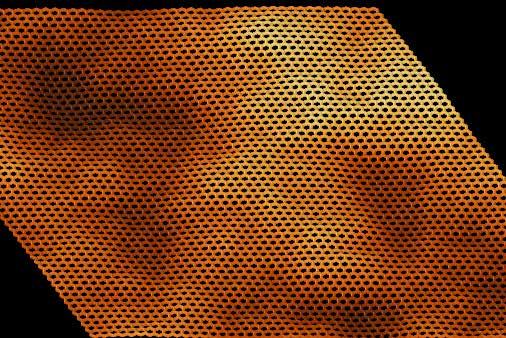
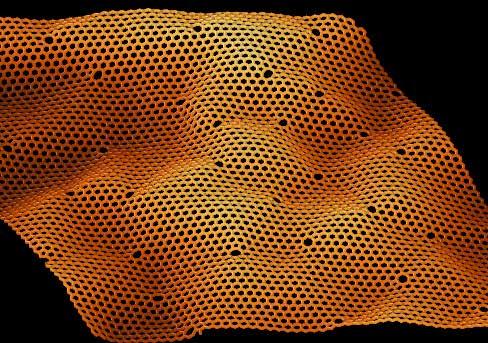
Your computer screen may appear flat but it is actaully undulating on the atomic level. The image to the left shows a computer simulation of a perfect screen with no defects that ripples predictably. Below it is the same sheet but with holes in it. Instead of being smooth, the surface is rough and bumpy and has frozen in place.
Defects in two-dimensional materials (such as an atom-thick sheet of graphene) can dramatically alter the way that the surface ripples, even stopping the sheet in place like a freeze frame.
Rippling is a crucial property of 2D materials and influences strength, conductivity, chemical activity and fluid interactions. Understanding the relationship between rippling and defects is essential for key technologies such as flexible electronics, energy storage, catalysis and nanofluidics. This research is published in The Proceedings of the National Academy of Sciences.
Dr Fabian Thiemann, the first author on this paper, started this research during his PhD between UCL, the University of Cambridge and Imperial College London. He is now a Research Scientist at IBM.
He said: “While experiments can capture the overall shape of rippled membranes, they struggle to resolve how these structures evolve at the atomic scale over time.
“Our simulations bridge this gap, allowing us to track the rippling dynamics in detail and uncover the role of microscopic defects in shaping the material’s morphology.”
2D materials are at the forefront of technological research, such as in ultrathin flexible screens, faster electronics and water filtration. What may seem like a flat surface though is never truly flat on the atomic level. Like a pond, these 2D surfaces have tiny ripples that affect their properties.
The researchers used machine learningbased computer models that represent 2D sheets of graphene and other materials. With these models, they can observe the rippling behaviour of different materials with and without defects. They found that defects in the sheet affect the way that ripples move and, most crucially, that above a certain concentration, the defects freeze the membrane and it loses its flexibility.
Prof. Angelos Michaelides who leads the Interfaces: Catalytic and Environmental (ICE) Group at our Department commented: “The wholescale impact such a small proportion of defects can have on the dynamics of graphene is remarkable. The prospects for exploiting these new fundamental insights are exciting and numerous, particularly in nanofluidics.”
Dr Camille Scalliet worked on this project when she was a Herchel Smith
Images supplied by Camille and Fabian.
Postdoctoral Fellow at the University of Cambridge. She is now a permanent researcher at the Laboratoire de Physique de l’École Normale Supérieure in Paris.
She commented: “By understanding how defects influence these ripples, our work helps engineers control the physical behaviour of these materials by using defects – something traditionally considered undesirable –as a design tool.”
Erich A Müller, Professor of Thermodynamics at the Department of Chemical Engineering, Imperial College London, commented: “This work is a premier example of how machine-learning potentials (a subdiscipline of artificial intelligence) are transforming the field of materials science by enabling more accurate, efficient and data-driven predictions of material properties.
“This is accelerating materials discovery and design, leading to the development of novel materials with desired functionalities for various applications.“
Looking ahead, the researchers are eager to build on these findings. Reflecting on the future of their research, Fabian Thiemann and Camille Scalliet shared: “There are great ways to continue this work. Our next steps are to study more complicated situations at the nanoscale such as membranes in contact with water or other materials. This is just the beginning for this collaboration.”
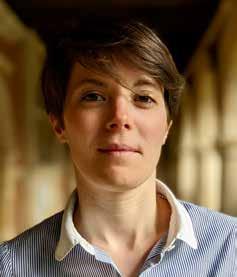
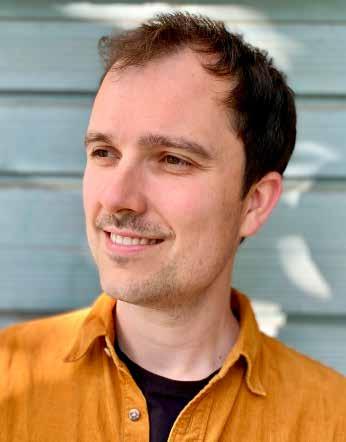
DrMobbassar Hassan Sk is a senior research associate in the Paul Davies and Mike Casford Group. Two years ago Hassan shared his experience of researching and lecturing with a lifelong stammer and the techniques he used to enhance his science communication.
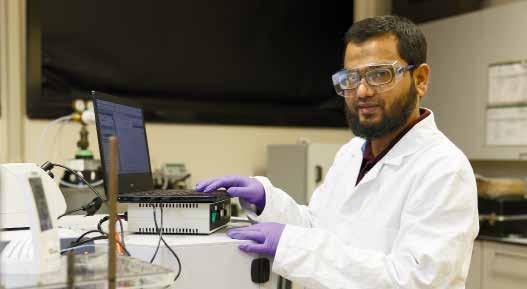
Since then, Hassan has been on two training courses and has developed new techniques and can now control his speech without stammer.
Hassan attended workshops from two different organisations (Starfish and Empowering Voice) and both have been crucial on his journey. His first course was with Starfish in 2022, then he attended Empowering Voice (2024) which helped him learn ‘costal breathing’, the technique that helps him control his voice.
Hassan explains the technique: “Costal breathing is taking fast and full breaths, speaking at the top the breath with deep tone, releasing the extra breath completely with pause, smile with eye contact. Costal breathing helps me get more air so I get a better quality of sound when I speak.
“A useful teaching for me was focusing on the vibrations in my chest for deep tone when I speak as opposed to in my mouth which has helped me speak louder as well. To be able to visualise that
I am talking with my chest rather than with my mouth has been very helpful. All these bits come as a package and with practise in various situations full technique will gradually become inherent.
“For me the change has been in every aspect of my life, like this interview we’re having now. It was a big challenge for me to deliver talks and I would use a speech synthesiser.
“If there are situations where I can’t use the technique my speech starts to trip over. The stammer doesn’t go away but I have met people who have been using this technique for decades and it becomes inherent.”
Hassan worked with Stuart Clarke until 2023 and then joined another project with Paul Davies and Mike Casford on lubrication research. Lubrication oil has thousands of chemical components that are difficult to analyse as a complete product and it is essential to separate the components to analyse them individually. He has developed an in
house technique to separate lubrication components and analyse them individually using a range of analytical techniques.
Alongside this research, he is also working on battery research looking at corrosion. “I’m gradually shifting my experience and techniques. In my previous projects I developed techniques for in situ analysis and now I am applying them to battery research.”
In his previous project he has designed and developed a unique suite of custom made in situ sample-cells where specific high resolution analytical techniques are combined with simultaneous electrochemical measurement capability to study interfacial degradation/ corrosion of batteries in real time under conditions of commercial relevance.
Since the course, Hassan joined the empowering-voice (a 100% charity organisation) support group and went to the course refresher where he helped newcomers to learn the technique, he also joined ‘The Cambridge Self-help Group for Adults Who Stammer’. Both these groups call for regular monthly meetings for sharing ideas and practise various skills and they are approved by the British Stammering Association (STAMMA), the largest UK charity and membership organisation representing people who stammer.
The University of Cambridge sponsored Hassan’s training with Empowering Voice and he adds: “The support I have had has been very helpful. I thank the University, my supervisor and colleagues – Paul Davies, Stuart Clarke, Mike Casford, Nick Bampos and James Keeler – who have been very supportive.”
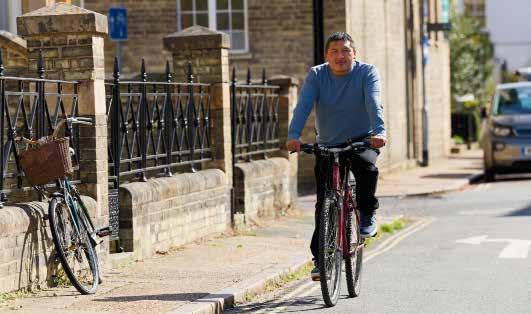
Dr Lautaro Nicolás Acosta is a Visiting Research Fellow from Argentina working with Prof. Dame Clare Grey’s Group for six months.
His home University is the Research and Development Center for Advanced Materials and Energy Storage of Jujuy, Argentina where he is a postdoc studying lithium-sulphur batteries under the supervision of Dr Alvaro Yamil Tesio. The Visiting Research Fellowship scheme is setup by the Faraday Institution and strengthens partnerships between the UK and the lithium triangle countries Argentina and Chile by supporting Early Career Battery Researchers. His PhD was in engineering so his expertise is a valuable addition to the Grey Group.
Lithium-ion batteries contain two plates called cathode and anode, which release or accept lithium in a rocking chair mechanism, so that current can flow during charge and discharge across an electrolyte that is placed between the two plates. Lithium is hosted in a crystalline structure in the cathode side and in graphite in the anode side. Due to cycling conditions all these components can be exposed to a continuous degradation mechanism,
as particle cracking, gas evolution or transition metal dissolution decreases the performance of the battery.
In the Grey Group, Lautaro is using specially designed cells that allow him to study the electrochemical processes that happen in the cathode and see how its performance changes as it charges and discharges over hundreds of cycles. The material starts out pristine so any defects that appear are as a result of the charging cycle. These results will inform r esearch into battery material stability with the potential to develop longerlasting batteries.
Lautaro wanted to experience research around the globe and the Faraday Institution programme was the perfect opportunity. “My experience with the Faraday Institution has been great, the laboratory setting is fantastic. The facilities and workshop enable research to answer niche questions.”
While at the Department, Lautaro has been able to collaborate with Clare Grey and other members of the Group and while continuing his collaborations in Argentina. Outside the laboratory, Lautaro is enjoying Cambridge’s cycling
lifestyle and the beautiful landscapes that the city has to offer.
“Alongside the laboratories I will remember the weather, though not in such a good way!”
Lautaro’s father was a car mechanic so, as a child, Lautaro watched him pull cars apart, put them back together and make them work again. “I was obsessed with how things worked and I would take things apart too to try and put them back together. Growing up around my dad and his workshop definitely made me want to study engineering.”
Lautaro ended up fulfilling this dream studying his engineering degree at the at National University of Jujuy, then his PhD at the National University of Salta.
“Argentina has a history with nuclear energy. We have three nuclear powerplants in the country now, so when I started University I was interested in studying nuclear engineering. For my PhD, I studied alternate energy sources to nuclear energy looking at the isotopic separation of lithium and this quite naturally led to my study of lithium use in batteries.”
Batteries are an essential step towards reducing our reliance on fossil fuels and carbon-emissions. Lautaro explains: “We need batteries to make cleanenergy sources consistent and reliable. Because of the intermittent nature of some green renewable energy, we need batteries to store backup energy and also for a transition to an electric vehicle fleet.”
After his visit, he will return to his postdoc in Jujuy and continue his research into higher energy density batteries that are more efficient and last longer.
In our outstanding workshop teams, skilled professionals across several disciplines contribute to the success of our Department. Among them is Shaun Impey, a dedicated mechanical engineer who built a metre-squared solar reactor for the Reisner Lab’s work on upscaling their waste-to-hydrogen technology.
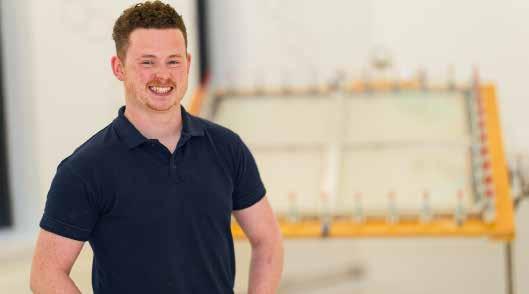
While he originally trained in carpentry, Shaun joined the Department under a Higher Apprenticeship in Mechanical Engineering. He has since transitioned fully into mechanical engineering, bringing valuable hands-on experience to the Mechanical Workshop – just one of the many specialist workshops that support our students and staff. Thanks to his experience and his out-of-the-box problem-solving skills, the one metresquared reactor was a successful proofof-concept and there are certainly more bespoke builds in his future.
The solar reactor makes hydrogen from aqueous waste solutions using sunlight as an energy source and a catalyst to enable the reaction. This is a clean source of hydrogen fuel and helps reuse biomass
or plastic waste that is otherwise burned or sent to landfill. Prototype solar reactors can be quite small and more straightforward to build, but this research is upscaling the science from the lab bench to the real world.
Before joining the Department in 2018, Shaun found himself redundant from his carpentry job making wardrobes and the Department workshop was a great next challenge.
“When I arrived, it was a very different workplace to what I was used to, a lot of different tools to learn but now it all just feels like second nature. As a woodworker, I used drills, saws and sanders but now the demands are more varied: welding, laser cutting, computer
numerical controlled milling machines, just about everything. I used to work from someone else’s design to make wardrobes but now I do everything from initial concept to finished product.”
Different projects at the workshop take different amounts of time and the reactor was one of Shaun’s larger projects taking six months. He can make smaller components, like custom replacement parts, in a few weeks and often with a much lower price tag.
Shaun reflects that: “For me, the biggest design challenge was that this contraption needs to be liquid tight and airtight and it is also 1.1 metre squared.”
Additionally, a lot of Perspex on the market blocks UV light. This is useful for everyday use since UV light can damage skin but disastrous for the solar reactor which benefits from these powerful wavelengths to function. Fortunately, Shaun had an innovative solution:
“The only suppliers I could find in the UK that sold specialist Perspex that large were sun bed specialists. It had to be one sheet to guarantee that it was water tight.”
He also collaborated with the researchers to make the device versatile, choosing to seal the window with sixty clamps (bright red in the photos) as opposed to screwing the panel in so that the scientists could access the catalysts easily.
One of these scientists is Ariffin Mohamad-Annuar, a third-year PhD student in the Reisner Lab, who led this research, which will be published later in the year. He wanted to upscale their smaller solar reactor prototypes into a large version that was designed to be modular and enable outdoor testing.
“One of the innovations is that we have a catalyst that we can spray onto the panel. Some catalysts need high temperatures or pressures when they are applied but this one is applied with a simple airbrush. It is convenient.”
The panel in the solar reactor began producing hydrogen gas when it was left outside in the sun. The team rotated it every hour-and-a-half for the mostdirect sunlight. After the success of this panel, Ariffin will be working with the workshop again to design the next version of the solar reactor.
“We want to work another design next to make it more efficient and try out some new ideas.”
The Reisner Group entered an earlier, smaller prototype solar reactor also made by the workshop into the 2022 European Innovation Council’s (EIC) Horizon Prize competition. This version
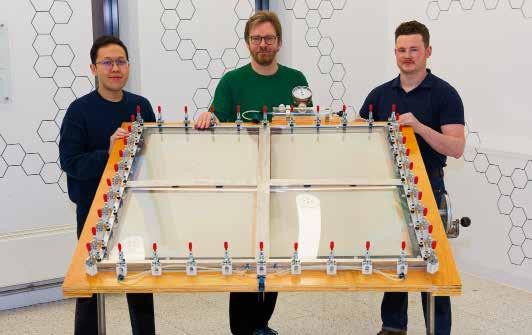
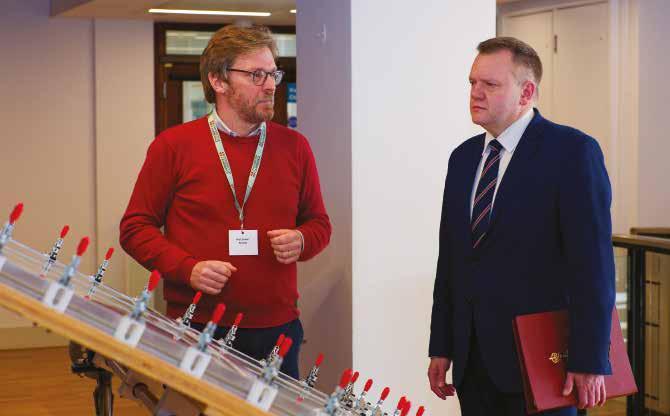
also had a modular design with rows of little green artificial ‘leaves’ laid across the device powered by sunlight. It turned carbon dioxide and water into syngas.
The prototype allowed them to come second in this global competition and the outdoor testing gave the team plenty of data and ideas to take back to the drawing board.
Prof. Erwin Reisner, the RAEng Chair in Emerging Technologies, comments: “We need to test prototypes at scale outdoors to build a technology that later works in the real world.”
Matthew Woolley, head of technical services, says: “We enjoy making prototypes as each one offers a unique set of challenges. It is really rewarding when you see equipment that you have designed and manufactured working as intended. In Shaun’s case, the first prototype hydrogen cell worked very well but throw up some difficult challenges to overcome. We are now looking forward to manufacturing a second, improved version this year which will deliver even better results!”.
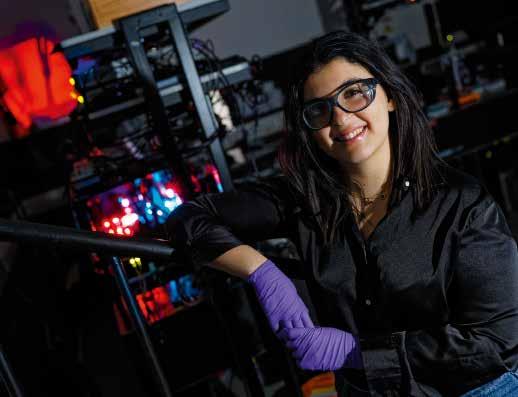
Dr Leila Nahidiazar interviews Livia Occhipinti, a first-year PhD student at the Lee Lab. Livia specialises in fluorescence microscopy and is collaborating with AstraZeneca to investigate new immunotherapeutic drugs.
Beyond their scientific work, they share their experiences as expatriate researchers, reflecting on the challenges and opportunities of working abroad. Their conversation offers insights into both their cutting-edge discoveries and the personal journeys that brought them here.
I’m originally from Sicily and I moved to Cambridge in 2018 to pursue my A-levels and have continued my academic journey in the UK ever since.
I earned my BSc in Biochemistry at King’s College London before returning to Cambridge to join the Engineering and Physical Sciences Research Council Centre for Doctoral Training (CDT) in Sensor Technologies for a Healthy and Sustainable Future.
This four-year programme, which combines an MRes and a PhD, has allowed me to explore a wide range of scientific disciplines, including chemistry, physics and engineering.
For my PhD, I am specialising in single-molecule fluorescence microscopy, funded by AstraZeneca to study the behaviour of novel immunotherapeutic drugs at a molecular level and drive more effective drug development.
My research sits at the intersection of biochemistry, biotechnology and biophysics. I find it incredibly exciting to contribute to work with such promising real-world applications.
What makes your job here in Cambridge unique?
What makes my work particularly unique is its collaborative nature. Being part of a Research Group with strong ties to both academia and industry allows me to combine cutting-edge research with real-world application to drive impactful solutions.
As Prof. Lee always says, our Group’s core mission is to develop new methods to address fundamental biological problems. This vision continues to inspire me, driving me to seek creative and impactful solutions in my research.
How would you compare Cambridge to your hometown?
I come from Ragusa, a small town in the south-eastern part of Sicily, known for its stunning Baroque architecture and vibrant atmosphere. In contrast, Cambridge is a highly international city with a strong academic presence and a rich intellectual history.
The biggest difference for me is the pace of life. In Ragusa, time seems to slow down and the lifestyle is more relaxed. Cambridge, on the other hand, moves at a much faster rhythm, especially in academic circles, where the intellectual energy is constant and dynamic.
Cambridge’s reputation for academic excellence is well deserved, with a long history of ground-breaking discoveries that continue to shape the world. This legacy not only inspires future innovations but also creates a unique intellectual energy that pushes you to think critically and creatively.
Beyond academics, Cambridge has a rich cultural scene. No matter your interests, there’s always something happening – whether it’s lectures, concerts, theatre, or festivals –bringing people together in a shared passion for learning and exploration. The combination of academic rigour and cultural vibrancy makes Cambridge an incredibly inspiring place to grow, both personally and professionally.
What memory from your time in Cambridge will stay with you as you move forward?
The formal dinner after my matriculation at Downing College will always hold a special place in my heart. That evening marked the official start of my journey at Cambridge, a moment when I truly felt part of this historic community.
The atmosphere was magical – the glow of candlelight, the grandeur of the hall and the sea of black gowns all came together to create an unforgettable memory, one that I will carry with me wherever I go.
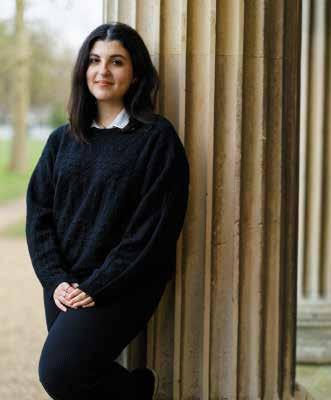

Dr Leila Nahidiazar
The interviewer for this article, Leila, worked in the Lee Lab. She researched Parkinson’s disease using cutting edge knowledge and newly emerging microscopy methods. Originally from Iran, she lived in the Netherlands before moving to Cambridge.
A writer and poet in her free time, this is her last column for Chem@Cam. Her bilingual poetry book in Dutch and Persian, “het ziellicht van een vrouw”(the soul-light of a woman), was published in March earlier this year. We wish her the best of luck on her next adventure.
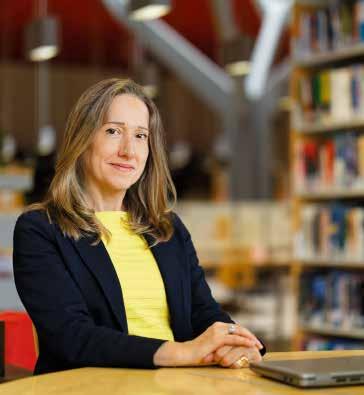
As the newly appointed editor-in-chief of Chem@Cam, I’m excited to take on this role and, alongside my colleagues, contribute to the continued success of this dynamic chemistry magazine.
I look forward to working together with the team as we continue to evolve Chem@Cam, ensuring it remains engaging and thought-provoking for our readers, while continuing to cultivate an inclusive environment where all voices from our alumni and the wider chemistry community can be heard.
We warmly invite you to share your thoughts, insights and experiences with us. Your voice matters and we are eager to hear from you!
Thank you for your continued support.
Kind regards

Fiorella Dell’Olio
Congratulations to Dr Jon Stonehouse, who won our winter Chem@Cam cryptic crossword prize draw and has received a sustainable Yusuf Hamied Department of Chemistry travel cup.
Jon completed his PhD in Prof. James Keeler’s Group in 1994 in new nuclear magnetic resonance spectroscopy techniques. He recalls his time in the Department:
“I had left a really brilliant NMR job and folks at Glaxo to do my PhD with James. It was an amazing experience and group dynamic and we were doing exciting new things in a hot subject!
I have many, many good memories of the Department, ranging from an afternoon lab-punting outing and sinking the punt (and many sets of keys) when we rode the punt down the rollers near Granta Place.
I also recall James standing in the taxi/ chauffeur line at Gatwick to meet us after returning from a conference in Asilomar, California. Where the dozens of taxi drivers were holding up placards with names of their passengers, James was holding up a Maurice Goldman NMR text. Fabulous.
I worked for Procter & Gamble for 30 years, always using my Chemistry and using NMR to understand how consumer products work – in terms of the molecular properties and interactions that drive performance or problems. The last 15 years I was also the technical leader for P&G to help detect and prevent counterfeiting of P&G’s products which has been a dream role.
I learned so much about printing, coding, detection from a mobile photo, deep learning, in-field chemical testing and multi-variate mapping of trends.
I retired in October 2024. Now, enjoying dog walking with my wife, Jo, time with our 3 daughters and Mitzi the golden retriever.
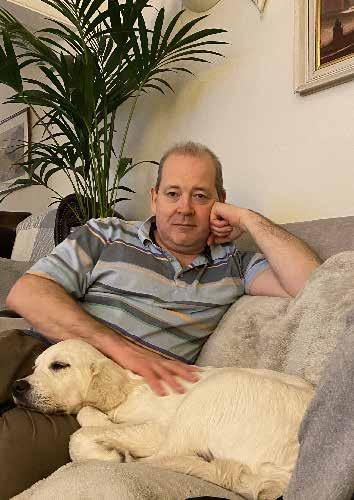
Challenge yourself with a cryptic crossword designed by Dr Tomas Deingruber who did his PhD in the Spring Group and now continues his research as a postdoc.
He works on antimicrobial compounds and synthesises small molecules that tackle bacteria. In a paper that was recently published in Nature Communications, he prepared enzyme inhibitors for a bacterium that affects people with cystic fibrosis.
Tomas was first introduced to cryptic crosswords when he solved the Trinity College cryptic crossword together with his colleagues in the Spring Group and since then it’s been a tradition.
“It was my first exposure to cryptic crosswords – I even bought a cryptic crossword book to better understand the different rules that they follow. I tried to apply as many of the rules as I could in this one.”
Across
1. Right, each medical instrument will undergo a change (5)
3. Degree in a gun element (6)
6. Really small – neither alpha nor omega at the beginning (4)
8. Mark is about to embrace confused mom (5)
10. Metal container (3)
11. A “hey”? Twisted approval! (4)
13. Happy birthday twice, to start with, followed by some cheap items from a furniture retailer (7)
14. Encountered a mixed source of metal in a shooting star (6)
17. Secures some spilt ether solutions (7)
20. Active atop of a queue (6)
21. On nudge tumbled underground (7)
22. A bush from the Spanish and the German (5)
Down
1. Escape New York to reject the extremely severe condition? (5,4)
2. Fabric for much hidden inside empty couch (5)
4. Natural profile (3)
5. Remove a car staying next to a Roman fort – sounds like it could make things heated! (7)
7. Hidden attire takes a little off what was passed on to you (9)
8. A show with naked Persian around (7)
9. European anthem oddly caused greenhouse effect (7)
12. The sheep sound like you (3)
15. Hermione starved of hydrogen and oxygen can get furry (6)
16. See 1 down
18. Gosh, wild pigs! (4)
19. Protest against every other rhino sty (4)


Send a photo of your answers by 1 August to crossword@ch.cam.ac.uk for a chance to win a sustainable Yusuf Hamied Department of Chemistry travel mug. The first correct answer to be drawn after the deadline will win. Answers will be sent out in our alumni email. If you don’t receive our emails, please make sure you’ve opted into receiving emails by logging into the University of Cambridge alumni website (www.alumni.cam.ac.uk).
26 September 2025 6pm in the Cybercafé
Once again, we are opening our doors for the Alumni Festival. Keep an eye on your email inboxes as ticket information will arrive in the summer.

This year join us for our popcorn and prosecco event where one of our Research Groups will showcase their incredible science along with demonstrations.
Last year Dr Jenny Zhang and her laboratory showcased their research working alongside nature to generate renewable energy. Audiences enjoyed sustainable science, demonstrations and festivities.